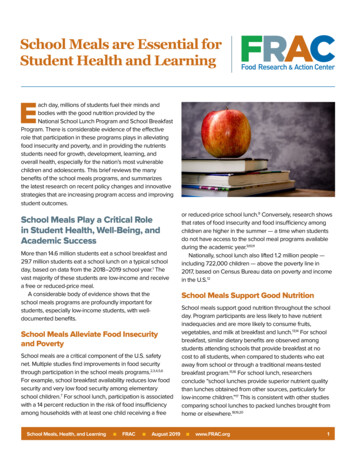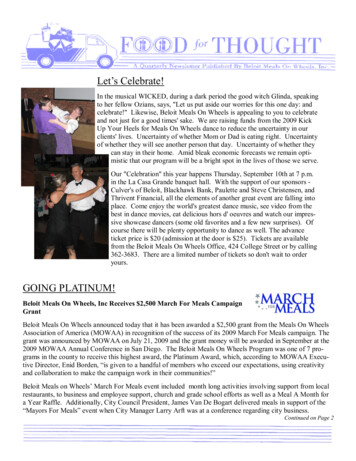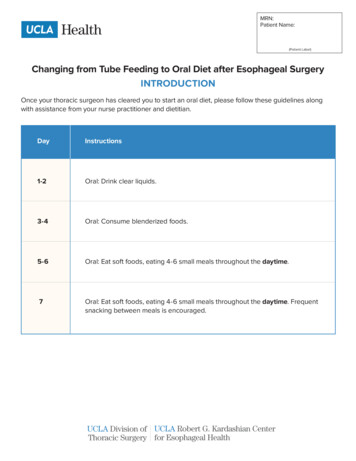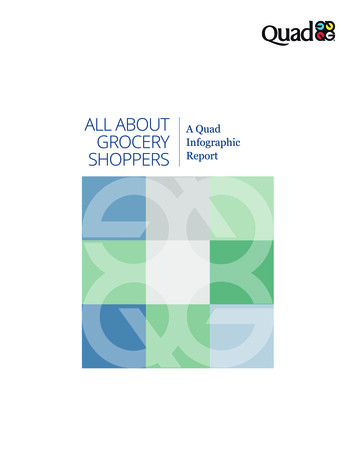
Transcription
School Meals are Essential forStudent Health and LearningEach day, millions of students fuel their minds andbodies with the good nutrition provided by theNational School Lunch Program and School BreakfastProgram. There is considerable evidence of the effectiverole that participation in these programs plays in alleviatingfood insecurity and poverty, and in providing the nutrientsstudents need for growth, development, learning, andoverall health, especially for the nation’s most vulnerablechildren and adolescents. This brief reviews the manybenefits of the school meals programs, and summarizesthe latest research on recent policy changes and innovativestrategies that are increasing program access and improvingstudent outcomes.School Meals Play a Critical Rolein Student Health, Well-Being, andAcademic SuccessMore than 14.6 million students eat a school breakfast and29.7 million students eat a school lunch on a typical schoolday, based on data from the 2018–2019 school year.1 Thevast majority of these students are low-income and receivea free or reduced-price meal.A considerable body of evidence shows that theschool meals programs are profoundly important forstudents, especially low-income students, with welldocumented benefits.School Meals Alleviate Food Insecurityand PovertySchool meals are a critical component of the U.S. safetynet. Multiple studies find improvements in food securitythrough participation in the school meals programs.2,3,4,5,6For example, school breakfast availability reduces low foodsecurity and very low food security among elementaryschool children.7 For school lunch, participation is associatedwith a 14 percent reduction in the risk of food insufficiencyamong households with at least one child receiving a freeSchool Meals, Health, and LearningnFRACnAugust 2019or reduced-price school lunch.8 Conversely, research showsthat rates of food insecurity and food insufficiency amongchildren are higher in the summer — a time when studentsdo not have access to the school meal programs availableduring the academic year.9,10,11Nationally, school lunch also lifted 1.2 million people —including 722,000 children — above the poverty line in2017, based on Census Bureau data on poverty and incomein the U.S.12School Meals Support Good NutritionSchool meals support good nutrition throughout the schoolday. Program participants are less likely to have nutrientinadequacies and are more likely to consume fruits,vegetables, and milk at breakfast and lunch.13,14 For schoolbreakfast, similar dietary benefits are observed amongstudents attending schools that provide breakfast at nocost to all students, when compared to students who eataway from school or through a traditional means-testedbreakfast program.15,16 For school lunch, researchersconclude “school lunches provide superior nutrient qualitythan lunches obtained from other sources, particularly forlow-income children.”17 This is consistent with other studiescomparing school lunches to packed lunches brought fromhome or elsewhere.18,19,20nwww.FRAC.org1
The school meals programs also have favorable impactson overall dietary quality, as measured by the Healthy EatingIndex.21,22 In a national assessment conducted by the U.S.Department of Agriculture (USDA), school lunch participantsand school breakfast participants consumed lunches andbreakfasts of higher nutritional quality, respectively, thantheir nonparticipating peers.23 In many cases, particularly forschool lunch participants, these differences in overall dietaryquality persisted over a 24-hour time period. Meaning,school meal participants had better dietary quality not justat school, but throughout the entire day. Similarly, there isevidence that more frequent school meal consumption hasnutritional advantages for daily dietary intake: elementaryand middle school students who eat school breakfast everyday consume more fruits and vegetables, whole grains,dairy, fiber, and calcium per day, when compared to studentswho eat school breakfast less frequently (i.e., 0 to 4 daysper week).24 Students who eat school lunch daily consumemore dairy and calcium per day compared to those whoeat school lunch less frequently. As Frisvold and Pricewrite, “exposure to healthier meals at school increasesthe healthfulness of foods acquired by children throughoutthe day.”25School Meals Improve Health OutcomesSchool meals support and improve student physicaland mental health, including weight-related outcomes. Forinstance, free or reduced-price school lunches reduce ratesof poor health by at least 29 percent and rates of obesityby at least 17 percent, based on estimates using nationaldata.26 Multiple studies find an association between schoolbreakfast participation and lower body mass index (BMI),lower probability of being overweight, and lower probabilityof obesity.27,28,29,30 School breakfast, including breakfastoffered at no cost to all students in a school, also has beenlinked with fewer visits to the school nurse, particularlyin the morning,31 and positive impacts on mental health,including reductions in behavioral problems, anxiety, anddepression.32,33School Meals Boost LearningSchool meals programs are linked with improvements inthe classroom. Students who participate in school breakfastprograms have improved attendance, behavior, academicperformance, and academic achievement as well asdecreased tardiness, based on decades of research onthe topic.34,35,36,37 These effects also are observed whenimplementing innovative models to increase breakfastparticipation. For example, providing students with breakfastin the classroom is associated with lower rates of tardiness,fewer disciplinary office referrals, improved attendancerates, and improved math and reading achievement testscores.38,39,40Improvements in student behavior have beenobserved with the Community Eligibility Provision* as well:multiple out-of-school suspension rates fell by about 15percent for elementary students and 6percent for middle school students afterimplementation of community eligibility inone study.41 These reductions were evenlarger, at about 25 percent, for elementaryschool students in counties with high ratesof food insecurity.Finally, research demonstrates thatthe impacts of program participation canbe long-lasting. In a study examiningthe effects of school lunch participationbetween 1941 and 1956 on adult outcomes,participation was associated with long-termeducational attainment for menand women.42* Under the Community Eligibility Provision created by the Healthy, Hunger-Free Kids Act (HHFKA) of 2010, high-poverty schools and school districts can offer schoolmeals at no charge to all students.School Meals, Health, and LearningnFRACnAugust 2019nwww.FRAC.org2
Updated School Meals NutritionStandards Improve Student DietaryIntake Without Harming ProgramParticipationThe Healthy, Hunger-Free Kids Act (HHFKA) of 2010created a process for enhancing the quality of all food andbeverages served and sold in schools by empoweringUSDA to set new nutrition standards for school meals andfor “competitive foods.”† These new nutrition standards arevital to improving the dietary intake and health of students,especially low-income students. USDA issued a final rule onthe school meal nutrition standards in January 2012. Overall,the rule required schools to offer more fruits, vegetables,and whole grain-rich foods; offer only fat-free or low-fat (1percent) fluid milk; limit saturated fat and sodium; minimizetrans fat; and limit the calories that can be offered in a meal.The lunch standards began to take effect in the 2012–2013school year; the breakfast standards began to take effect inthe 2013–2014 school year.An analysis by FRAC in 2016 found that the revisednutrition standards have had a positive impact on the schoolnutrition environment as well as student food selection andconsumption, especially for fruits and vegetables.43 Researchpublished since then supports these conclusions.44,45,46Perhaps most notably, USDA recently issued the firstnational, comprehensive assessment of school mealprograms since the implementation of the updated schoolmeal nutrition standards.47 The nutritional quality of schoollunches increased by 41 percent, and by 44 percent forschool breakfasts, after the implementation of the nutritionstandards. The assessment also found that serving lunchesof higher nutritional quality was associated with higherschool lunch participation rates, but not with higher costsper lunch.In addition to the favorable nutrition impacts, thereis growing evidence that the standards have not had anegative impact on school meal participation over time (assome had feared) and, in fact, may contribute to modestimprovements in participation.48,49 For instance, the numberof students choosing a school meal (versus no schoolmeal) increased by 13.6 percent after the implementationof improved school meal and competitive food nutritionstandards in Massachusetts.50In spite of widespread support, overwhelming evidenceof compliance, and positive nutrition impacts, efforts havebeen underway to roll back the nutrition standards issuedin January 2012.51,52,53 Unfortunately, such efforts weresuccessful with the weakening of the standards for wholegrains, sodium, and milk in a final rule issued by USDAin December 2018. USDA scaled back the whole grainrequirements, delayed the requirement to further lowersodium levels in school meals, and allowed low-fat flavoredmilk (instead of only allowing non-fat flavored milk). Inresponse, FRAC released a statement that “USDA’s finalrule on nutrition standards is a step backwards for children’shealth and learning.”54 Regardless of this setback, FRAC willcontinue to work with schools and districts to implement thestronger nutrition standards issued in January 2012, sincethose aspects of the standards issued in December 2018are optional for schools. On the national level, FRAC willwork with allied organizations in efforts to protect thenutrition standards from rollbacks, and advocate for USDAto ensure adequate support, technical assistance, andresources for schools to continue robust implementationof the nutrition standards.† The new competitive foods standards rule, known as the Smart Snacks in School rule, is a separate initiative governing foods provided or sold in schools(e.g., vending machines, food sold in competition with federal meals) other than those from the federal nutrition programs. It was issued by USDA in June 2013 andbegan to take effect in the 2014–2015 school year. In general, these standards promote whole grains, low-fat dairy, fruits, vegetables, and leaner protein, whilelimiting the calories, fat, sugar, and sodium of items.School Meals, Health, and LearningnFRACnAugust 2019nwww.FRAC.org3
Innovative Policies and Practicesfor Providing School Meals IncreaseProgram AccessAcross the country, innovative school meal policies andpractices are being implemented to increase access tothese critical and effective programs. For school breakfastand lunch, this includes implementing community eligibility.For breakfast, this includes providing breakfast at no costto all students (possibly through community eligibility), andusing breakfast in the classroom, “grab and go” breakfast,and second chance breakfast models. Such approaches canaddress common barriers to program participation, such asstigma, cost, and, for breakfast, arriving to school too late.(For more information and resourceson these policies and models, visit www.frac.org.)Research shows that these strategies are effective inincreasing program participation. According to an analysisby FRAC, 28,542 schools (64 percent of those eligible)participated in community eligibility in the 2018–2019 schoolyear, compared to 14,214 in the 2014–2015 school year whenthe provision first became available nationwide.55 Whilecommunity eligibility has only been implemented nationwidea few years, preliminary evidence indicates that the provisionincreases student participation in school breakfast andlunch,56,57 and FRAC’s analysis points to a consistent increasein the number of students enrolled in schools offeringcommunity eligibility.The evidence is clear that programs offering breakfastat no cost to all students and breakfast in the classroomincrease breakfast participation.58,59,60,61,62,63,64,65 (Typically,breakfast in the classroom is offered at no cost to allstudents.) For example, in a study of North Carolina publicschools, serving breakfast at no cost to all students boostedbreakfast participation, including among students otherwiseineligible for free or reduced-price meals.66 The participationimpacts were larger when breakfast at no cost to all studentswas implemented in combination with breakfast in theclassroom, second chance breakfast, or breakfast in theclassroom plus “grab and go.”“Grab and go” and second chance breakfasts showparticular evidence of success for middle and high schoolstudents, although these models tend to receive lessattention in the research literature.67,68 In an evaluationSchool Meals, Health, and LearningnFRACnAugust 2019of a “grab and go” breakfast program in Minnesota highschools, average school-level breakfast participationincreased from 13 percent to 22.6 percent of students afterimplementation.69 Among a subsample of students withirregular breakfast habits, breakfast participation increasedamong students eligible for free or reduced-price schoolmeals (from 13.9 to 30.7 percent) and among students payingfull price for school meals (from 4.3 to 17.2 percent).ConclusionResearch shows that the school breakfast and lunchprograms are effective in alleviating food insecurity andpoverty, supporting good nutrition, and improving health andlearning. In addition, recent policy changes (e.g., communityeligibility, updated nutrition standards) and innovativemodels of program delivery (e.g., breakfast in the classroom)are connecting more students to these critical programs andproducing more positive and healthier outcomes. Continuingto increase access to, and strengthen, the school mealsprograms will further their role in supporting and improvingstudent health and well-being.This paper was prepared by FRAC’s Heather HartlineGrafton, DrPH, RD, Senior Researcher in Nutrition Policyand Community Health.nwww.FRAC.org4
Endnotes1U.S. Department of Agriculture. (2019). National Level Annual Summary Tables:FY 1969–2018 (preliminary data for Fiscal Year 2018). Available at: . Accessed on July 23, 2019.2Bartfeld, J., Kim, M., Ryu, J. H., & Ahn, H. (2009). The School Breakfast Programparticipation and impacts. Contractor and Cooperator Report, 54. Washington,DC: U.S. Department of Agriculture.3Bartfeld, J. S., & Ahn, H. M. (2011). The School Breakfast Program strengthenshousehold food security among low-income households with elementaryschool children. Journal of Nutrition, 141(3), 470–475.4Bartfeld, J. S., & Ryu, J. H. (2011). The School Breakfast Program and breakfastskipping among Wisconsin elementary school children. Social Service Review,85(4), 619–634.5Gundersen, C., Kreider, B., & Pepper, J. (2012). The impact of the NationalSchool Lunch Program on child health: a nonparametric bounds analysis.Journal of Econometrics, 166, 79–91.6Arteaga, I., & Heflin, C. (2014). Participation in the National School LunchProgram and food security: an analysis of transitions into kindergarten.Children and Youth Services Review, 47(3), 224–230.7Fletcher, J. M., & Frisvold, D. E. (2017). The relationship between the SchoolBreakfast Program and food insecurity. Journal of Consumer Affairs, 51(3),481–500.8Huang, J., & Barnidge, E. (2016). Low-income children’s participation in theNational School Lunch Program and household food insufficiency. SocialScience & Medicine, 150, 8–14.9Nord, M., & Romig, K. (2006). Hunger in the summer: seasonal food insecurityand the National School Lunch and Summer Food Service programs. Journalof Children and Poverty, 12(2), 141–158.16Polonsky, H. M., Davey, A., Bauer, K. W., Foster, G. D., Sherman, S., Abel, M. L.,Dale, L. C., & Fisher, J. O. (2018). Breakfast quality varies by location amonglow-income ethnically diverse children in public urban schools. Journal ofNutrition Education and Behavior, 50(2), 190–197.17Vernarelli, J. A., & O’Brien, B. (2017). A vote for school lunches: school lunchesprovide superior nutrient quality than lunches obtained from other sources ina nationally representative sample of US children. Nutrients, 9(9), E924.18Farris, A. R., Misyak, S., Duffey, K. J., Davis, G. C., Hosig, K., Atzaba-Poria, N.,McFerren, M. M., & Serrano, E. L. (2014). Nutritional comparison of packed andschool lunches in pre-kindergarten and kindergarten children following theimplementation of the 2012–2013 National School Lunch Program standards.Journal of Nutrition Education and Behavior, 46(6), 621–626.19Hubbard, K. L., Must, A., Eliasziw, M., Folta, S. C., & Goldberg, J. (2014). What’sin children’s backpacks: foods brought from home. Journal of the Academy ofNutrition and Dietetics, 114(9), 1424–1431.20Caruso, M. L., & Cullen, K. W. (2015). Quality and cost of student lunchesbrought from home. JAMA Pediatrics, 169(1), 86–90.21Hanson, K. L., & Olson, C. M. (2013). School meals participation and weekdaydietary quality were associated after controlling for weekend eating amongU.S. school children aged 6 to 17 years. Journal of Nutrition, 143, 714–721.22Ritchie, L. D., Rosen, N. J., Fenton, K., Au, L. E., Goldstein, L. H., & Shimada, T.(2015). School breakfast policy is associated with dietary intake of fourth- andfifth-grade students. Journal of the Academy of Nutrition and Dietetics, 116(3),449–457.23Fox, M. K., & Gearan, E. (2019). School Nutrition and Meal Cost Study:Summary of Findings. Alexandria, VA: U.S. Department of Agriculture, Foodand Nutrition Service.24Au, L. E., Gurzo, K., Gosliner, W., Webb, K. L., Crawford, P. B., & Ritchie, L. D.(2018). Eating school meals daily is associated with healthier dietary intakes:The Healthy Communities Study. Journal of the Academy of Nutrition &Dietetics, 118(8), 1474–1481.25Frisvold, D., & Price, J. (2019). The contribution of the school environment tothe overall food environment experienced by children. Southern EconomicJournal, published online ahead of print.26Gundersen, C., Kreider, B., & Pepper, J. (2012). The impact of the NationalSchool Lunch Program on child health: a nonparametric bounds analysis.Journal of Econometrics, 166, 79–91.10Nalty, C., Sharkey, J., & Dean, W. (2013). School-based nutrition programsare associated with reduced child food insecurity over time among Mexicanorigin mother-child dyads in Texas Border Colonias. Journal of Nutrition, 143,708–713.11Huang, J., Barnidge, E., & Kim, Y. (2015). Children receiving free or reducedprice school lunch have higher food insufficiency rates in summer. Journal ofNutrition, 145(9), 2161–2168.12Fox, L. (2018). The Supplemental Poverty Measure: 2017. Current PopulationReports, P60–265. U.S. Census Bureau.13Clark, M. A., & Fox, M. K. (2009). Nutritional quality of the diets of U.S. publicschool children and the role of the school meal programs. Journal of theAmerican Dietetic Association, 109(2 Supplement 1), S44–S56.27Gleason, P. M., & Dodd, A. H. (2009). School breakfast program but not schoollunch program participation is associated with lower body mass index. Journalof the American Dietetic Association, 109(2 Supplement 1), S118–S128.14Condon, E. M., Crepinsek, M. K., & Fox, M. K. (2009). School meals: types offoods offered to and consumed by children at lunch and breakfast. Journal ofthe American Dietetic Association, 109(2 Supplement 1), S67–S78.28Millimet, D. L., Tchernis, R., & Husain, M. (2010). School nutrition programsand the incidence of childhood obesity. Journal of Human Resources, 45(3),640–654.15Crepinsek, M. K., Singh, A., Bernstein, L. S., & McLaughlin, J. E. (2006).Dietary effects of universal-free school breakfast: finding from the evaluationof the School Breakfast Program Pilot Project. Journal American DieteticAssociation, 106(11), 1796–1803.29Millimet, D. L., & Tchernis, R. (2013). Estimation of treatment effects withoutan exclusion restriction: with an application to the analysis of the SchoolBreakfast Program. Journal of Applied Economics, 28, 982–1017.School Meals, Health, and LearningnFRACnAugust 2019nwww.FRAC.org5
30Wang, S., Schwartz, M. B., Shebi, F. M., Read, M., Henderson, K. E., &Ickovics, J. R. (2017). School breakfast and body mass index: a longitudinalobservational study of middle school students. Pediatric Obesity, 2(3),213–220.45Cohen, J. F. W., Gorski Findling, M. T., Rosenfeld, L., Smith, L., Rimm, E. B., &Hoffman, J. A. (2018). The impact of 1 Year of healthier school food policies onstudents’ diets during and outside of the school day. Journal of the Academyof Nutrition and Dietetics, 118(12), 2296–2301.31Bernstein, L. S., McLaughlin, J. E., Crepinsek, M. K., & Daft, L. M. (2004).Evaluation of the School Breakfast Program Pilot Project: final report.Nutrition Assistance Program Report Series, CN-04-SBP. Alexandria, VA: U.S.Department of Agriculture, Food and Nutrition Service, Office of Analysis,Nutrition, and Evaluation. (The findings on school nurse visits were onlyobserved for the 2001–2002 school year in this report.)46Mozer, L., Johnson, D. B., Podrabsky, M., & Rocha, A. (2019). School lunchentrées before and after implementation of the Healthy, Hunger-Free Kids Actof 2010. Journal of the Academy of Nutrition and Dietetics, 119(3), 490–499.47Fox, M. K., & Gearan, E. (2019). School Nutrition and Meal Cost Study:Summary of Findings. Alexandria, VA: U.S. Department of Agriculture, Foodand Nutrition Service.48Johnson, D. B., Podrabsky, M., Rocha, A., & Otten, J. J. (2016). Effect of theHealthy Hunger-Free Kids Act on the nutritional quality of meals selectedby students and school lunch participation rates. JAMA Pediatrics, 170(1),e153918.49Vaudrin, N., Lloyd, K., Yedidia, M. J., Todd, M., & Ohri-Vachaspati, P. (2018).Impact of the 2010 US Healthy, Hunger-Free Kids Act on school breakfast andlunch participation rates between 2008 and 2015. American Journal of PublicHealth, 108(1), 84–86.50Cohen, J. F. W., Gorski Findling, M. T., Rosenfeld, L., Smith, L., Rimm, E. B., &Hoffman, J. A. (2018). The impact of 1 Year of healthier school food policies onstudents’ diets during and outside of the school day. Journal of the Academyof Nutrition and Dietetics, 118(12), 2296–2301.51Kogan, R. (2019). Rollback Of Nutrition Standards Not Supported By Evidence(Health Affairs Blog). Available at: 0312.130704/full/. Accessed on July 16, 2019.52Schwartz, M. B., Brownell, K. D., & Miller, D. L. (2019). Primer on US food andnutrition policy and public health: protect school nutrition standards. AmericanJournal of Public Health, 109(7), 990–991.53Food Research & Action Center. (n.d.) Four Key Facts in Support of theImproved School Nutrition Standards. Washington, DC: Food Research &Action Center. Available at: n-standards. Accessedon July 17, 2019.54Food Research & Action Center. (2019). USDA’s Final Rule on NutritionStandards is a Step Backwards for Children’s Health and Learning. PressRelease. Available at: h-and-learning. Accessedon July 17, 2019.55Maurice, A., Rosso, R., FitzSimons, C., & Furtado, K. (2019). CommunityEligibility: The Key to Hunger-Free Schools (School Year 2018–2019). Availableat: . Accessed on July 24, 2019.323334Kleinman, R. E., Hall, S., Green, H., Korzec-Ramirez, D., Patton, K., Pagano,M. E., & Murphy, J. M. (2002). Diet, breakfast, and academic performance inchildren. Annals of Nutrition and Metabolism, 46(Supplement 1), 24–30.Murphy, J. M., Pagano, M. E., Nachmani, J., Sperling, P., Kane, S., & Kleinman,R. E. (1998). The relationship of school breakfast to psychosocial andacademic functioning: cross-sectional and longitudinal observations in aninner-city school sample. Archives of Pediatrics and Adolescent Medicine,152(9), 899–907.Murphy, J. M. (2007). Breakfast and learning: an updated review. Journal ofCurrent Nutrition and Food Science, 1, 3–36.35Basch, C. E. (2011). Breakfast and the achievement gap among urban minorityyouth. Journal of School Health, 81(10), 635–640.36Frisvold, D. E. (2015). Nutrition and cognitive achievement: an evaluation of theSchool Breakfast Program. Journal of Public Economics, 124, 91–104.37Murphy, J. M., Pagano, M. E., Nachmani, J., Sperling, P., Kane, S., & Kleinman,R. E. (1998). The relationship of school breakfast to psychosocial andacademic functioning: cross-sectional and longitudinal observations in aninner-city school sample. Archives of Pediatrics and Adolescent Medicine,152(9), 899–907.38Nutrition Consortium of NYS. (2005). Academics & Breakfast ConnectionPilot: Final Report on New York’s Classroom Breakfast Project. Albany, NY:Nutrition Consortium of NYS.39Anzman-Frasca, S., Djang, H. C., Halmo, M. M., Dolan, P. R., & Economos, C. D.(2015). Estimating impacts of a breakfast in the classroom program on schooloutcomes. JAMA Pediatrics, 169(1), 71–77.40Imberman, S. A., & Kugler, A. D. (2014). The effect of providing breakfast inclass on student performance. Journal of Policy Analysis and Management,33(3), 669–699.41Gordon, N. E., & Ruffini, K. J. (2018). School nutrition and student discipline:effects of schoolwide free meals. NBER Working Paper, 24986.42Hinrichs, P. (2010). The effects of the National School Lunch Program oneducation and health. Journal of Policy Analysis and Management, 29(3),479–505.56Hartline-Grafton, H. (2016). Research Shows that the School NutritionStandards Improve the School Nutrition Environment and Student Outcomes.Washington, DC: Food Research & Action Center.Levin, M., & Neuberger, Z. (2013). Community Eligibility: Making High-PovertySchools Hunger Free. Washington, DC: Food Research & Action Center andCenter on Budget and Policy Priorities.57Logan, C. W., Connor, P., Harvill, E. L., Harkness, J., Nisar, H., Checkoway, A.,Peck, L. R., Shivji, A., Bein, E., Levin, M., & Enver, A. (2014). Community EligibilityProvision Evaluation. Prepared by Abt Associates for the U.S. Department ofAgriculture, Food and Nutrition Service.4344Lin, B. H., Guthrie, J. F., & Smith, T. A. (2019). Dietary guidance and new schoolmeal standards: schoolchildren’s whole grain consumption over 1994–2014.American Journal of Preventive Medicine, 57(1), 57–67.School Meals, Health, and LearningnFRACnAugust 2019nwww.FRAC.org6
58596061Bernstein, L. S., McLaughlin, J. E., Crepinsek, M. K., & Daft, L. M. (2004).Evaluation of the School Breakfast Program Pilot Project: final report.Nutrition Assistance Program Report Series, CN-04-SBP. Alexandria, VA: U.S.Department of Agriculture, Food and Nutrition Service, Office of Analysis,Nutrition, and Evaluation. (The findings on school nurse visits were onlyobserved for the 2001–2002 school year in this report.).Bartfeld, J., Kim, M., Ryu, J. H., & Ahn, H. (2009). The School BreakfastProgram participation and impacts. Contractor and Cooperator Report, 54.Washington, DC: U.S. Department of Agriculture.Murphy, J. M., Pagano, M. E., Nachmani, J., Sperling, P., Kane, S., & Kleinman,R. E. (1998). The relationship of school breakfast to psychosocial andacademic functioning: cross-sectional and longitudinal observations in aninner-city school sample. Archives of Pediatrics and Adolescent Medicine,152(9), 899–907.Nanney, M. S., Olaleye, T. M., Wang, Q., Motyka, E., & Klund-Schubert, J. (2011).A pilot study to expand the school breakfast program in one middle school.Translational Behavioral Medicine, 1(3), 436–442.62Corcoran, S. P., Elbel, B., & Schwartz, A. E. (2016). The effect of breakfast in theclassroom on obesity and academic performance: evidence from New YorkCity. Journal of Policy Analysis and Management, 35(3), 509–532.63Anzman-Frasca, S., Djang, H. C., Halmo, M. M., Dolan, P. R., & Economos, C. D.(2015). Estimating impacts of a breakfast in the classroom program on schooloutcomes. JAMA Pediatrics, 169(1), 71–77.School Meals, Health, and LearningnFRACnAugust 201964Crepinsek, M. K., Singh, A., Bernstein, L. S., & McLaughlin, J. E. (2006).Dietary effects of universal-free school breakfast: finding from the evaluationof the School Breakfast Program Pilot Project. Journal American DieteticAssociation, 106(11), 1796–1803.65Farris, A. R., Roy, M., Serrano, E. L., & Misyak, S. (2019). Impact of Breakfast inthe Classroom on participation and food waste. Journal of Nutrition Educationand Behavior, 51(7), 893–898.66Soldavini, J., & Ammerman, A. S. (2019). Serving breakfast free to all studentsand type of breakfast serving model are associated with participation in theSchool Breakfast Program. Journal of the Academy of Nutrition and Dietetics,119(7), 1142–1149.67Soldavini, J., & Ammerman, A. S. (2019). Serving breakfast free to all studentsand type of breakfast serving model are associated with participation in theSchool Breakfast Program. Journal of the Academy of Nutrition and Dietetics,119(7), 1142–1149.68Nanney, M. S., Leduc, R., Hearst, M., Shanafelt, A., Wang, Q., Schroeder,M., Grannon, K. Y., Kubik, M. Y., Caspi, C., & Harnack, L. J. (2019). A grouprandomized intervention trial increases participation in the School BreakfastProgram in 16 rural high schools in Minnesota. Journal of the Academy ofNutrition and Dietetics, 119(6), 915–922.69Larson, N., Wang, Q., Grannon, K., Wei, S., Nanney, M. S., & Caspi, C. (2018). Alow-cost, grab-and-go breakfast intervention for rural high school students:changes in School Breakfast Program participation among at-risk
Department of Agriculture (USDA), school lunch participants and school breakfast participants consumed lunches and breakfasts of higher nutritional quality, respectively, than their nonparticipating peers.23 In many cases, particularly for school lunch participants, these differences in overall dietary quality persisted over a 24-hour time period.











